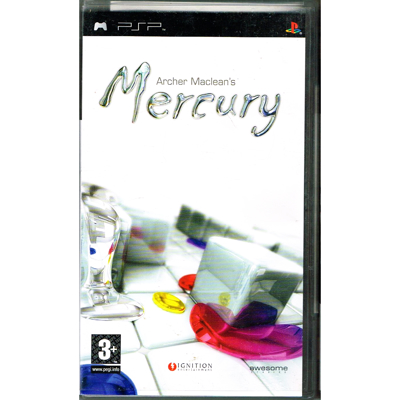ARCHER MACLEANS MERCURY PSP
ARCHER MACLEANS MERCURY PSP
Archer Maclean's Mercury is a video game for the PlayStation Portable, first released in April 2005 in North America. In Japan, the game was released under the name [Hg] Hydrium. Mercury is a puzzle game developed by the eponymous British game programmer, Archer MacLean. In Mercury, the player tilts a level in order to get a drop of mercury to its appointed destination, in a similar fashion to Marble Madness. Differences include newer obstacles and the ability for the mercury to morph, split and transform around the levels. The game was originally designed to use a tilt sensor that plugged into the PSP's USB port, but this was never released.
Mercury takes on similar gameplay to that of Marble Madness. The player guides a colored blob (called Mercury) around a floating stage. The objective of each level in the game is to guide the Mercury around the level, activating beacons using switches. The nature of a liquid is also utilized in Mercury: the blob can split up, change color, or change shape.
Many hazards also exist in each level of Mercury, meant to reduce the player's amount of liquid. In some levels, for example, there are no walls; if the blob of Mercury gets to close to the edge of the stage, parts of it may drop off the level, detracting from the Mercury count. The blob can also be split into two separate parts by a variety of means; the two blobs may then be moved around (and rejoined if they touch). The primary method of splitting a blob is by using a splitter, a triangle-shaped object. Pushing the Mercury against a splitter will split it into two pieces.
Color plays a large role in Mercury. In most levels, the blob starts out as a silver color. However, by moving under Paint Shops, the color of the Mercury can be changed. Some doors (called filters) only allow matching-colored Mercury to pass through; some switches are also color-coded. If the Mercury is split up, the two blobs can be colored differently; if the two then merge, they form a new color. Color mixing is based on the RGB color model, as opposed to the color rules of paint. For example, a red blob and a green blob merge to form a yellow one.
KOMPLETT I BOX


